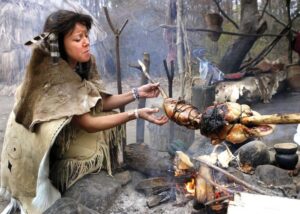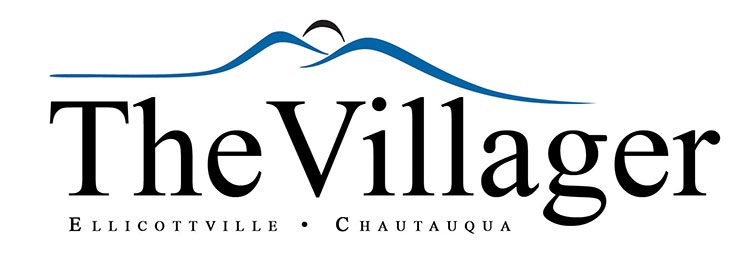Carol Fisher-Linn
Imagine yourself back in 1621 … perhaps you were a Pilgrim named Brewster, whose clothing was described in his will as “one blew clothe suit, green drawers, a vilolete clothe coat, black silk stockings, skyblew garters, red grograin suit, red waistcoat, tawny colored suit with silver buttons.” For this event, you might choose the “blew clothe suit” and a heavy woolen cape, and the few remaining women would be wearing long woolen dresses and woolen shawls to keep them warm. The men used leather ties for their breeches and their boots. Nope, no buckles.

The three-day feast likely took place in late September or early October following the harvest. Historical depictions of the gathering show the Wampanoags seated at tables or on the ground, bare chested. Perhaps it is a balmy fall or they are just tough, sturdy men. You are hungry and can’t wait for the meal to be served. The venison that the natives brought is on a nearby spit, likely along with whole wildfowl before glowing coals (yes, there were wild turkey, but they also had roasted goose, swans, or partridge and fish, shrimp, shellfish, and an assortment of seafood which was readily available), while other cooking took place in the household hearth using large brass pots for cooking corn (made into a mash), meat pottages (stews), or simple boiled vegetables. Sorry, no yams or mashed potatoes; cranberries were served whole and unsugared (berries were wild – sugar was used sparingly) and no pies!
If you want to experience a true 1621-themed dinner, pull out your calendar for 2024 and make a reservation in October or November to visit the Plimouth Plantation for the real deal. I believe when you eat there, you will have the usual utensils we are accustomed to today. However, Brewster and his cohorts had only a knife and spoon to eat with. Imagine trying to eat your meat with a spoon. Why did they not have forks? Well, it seems that the church made it clear that the utensil was an affront to God’s intentions for fingers. In foodreference.com, we find that “The modern table setting is attributed to Charles I of England who in 1633 declared, “It is decent to use a fork,” a statement that heralded the beginning of civilized table manners. But it wasn’t until almost a century later that the fork gained acceptance among the lower class.” To learn more about forks and their evolution, go to https://www.foodreference.com/html/art-history-fork-729.html.
A man named Edward Winslow wrote a letter in December 1621, in which he clearly described the first feast celebrated in thanksgiving for a successful harvest and for surviving the first brutal year in the new world (between 51-56 of 102 original Mayflower passengers died in the winter of 1620–21, 13 of them women, leaving only four when the first Thanksgiving came around). Winslow as one of the founders of Plymouth Colony in Massachusetts. His letter is the first eye-witness report of what took place during that time.
Fast forward to today: According to the National Turkey Federation, 46 million turkeys are expected to be eaten on Thanksgiving, and another 22 million on Christmas. While I’m boggling your mind with statistics, here’s another: According to the Calorie Control Council, the average American may consume more than 4,500 calories and 229 grams of fat on Thanksgiving day. As for what it would require to burn off all those calories, you’re looking at 15 hours of cycling, or a 10.3-hour hike.

settlement of the Plymouth Colony established in the 17th century by the English colonists who became known as the Pilgrims. -Wikipedia
We can’t talk about Thanksgiving without talking about the Macy’s Christmas Parade. Huh? Yep, that parade, which began on Thanksgiving in 1924 was actually a Christmas parade, complete with live animals on loan from the Central Park Zoo. No flying balloons overhead, the parade featured instead bears, elephants, camels and monkeys which created a circus-like atmosphere as four bands provided the soundtrack to the festive march. Bringing up the rear of the parade was a float bearing the guest of honor—Santa Claus—sitting in his reindeer-driven sleigh on top of a mountain of ice. And now, you know “the rest of the story.” Bonus points to anyone who can tell who said those words. “Happy Thanksgiving, everyone.”
